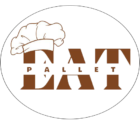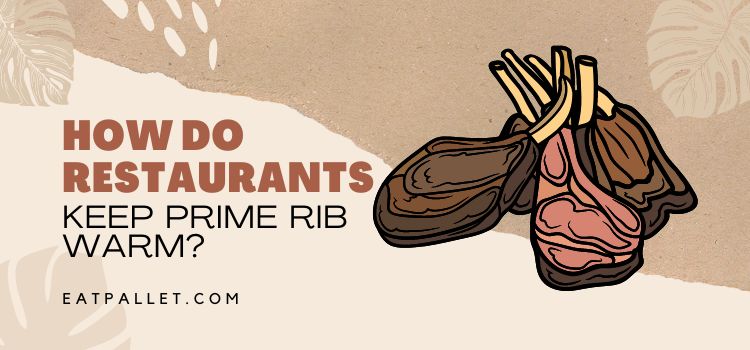Last Updated on July 17, 2024 by Shari Mason
Prime rib, commonly known as standing rib roast, is a savory dish that food lovers around the globe greatly enjoy.
Have you ever wondered how do restaurants keep prime rib warm and delicious?
Well, today, I’ll share the secrets that I gathered from an insider.
Join me as we uncover the simple techniques that restaurants use to maintain that perfect temperature and serve mouthwatering prime ribs to their guests.
2 Methods On How Restaurants Keep Prime Rib Warm
1. Using the Heat in the Oven


Based on my insider, restaurants use heat in the oven with temperatures ranging from 150 to 200 degrees Fahrenheit. If the temperature goes above 200 degrees Fahrenheit, the beef will begin to cook again.
Cover it tightly with foil before placing it in the oven with a low setting. This will prevent the outer layer from becoming overly crispy.
“Consistent warmth preserves prime rib’s juicy perfection at restaurants.”
–Eat Pallet Restaurant & Food Advice
While the ribs can be kept in the oven on low heat indefinitely, you will most likely want to remove them when ready to serve.
Remove it from the oven, leaving the foil on the meat, and set aside for 15 to 30 minutes before serving.
I tried this method when I served ribs last Thanksgiving, and it is a failproof method I’ll continue using.
Read:
- How To Cook A Frozen Beef Roast In The Oven?
- How To Cut A Bone In Prime Rib Roast Into Steaks?
- Can You Cook Two Prime Ribs In The Same Oven?
2. Utilizing Warming Plate
Restaurants use flat heating trays and warming plates to warm prime ribs. You can also transfer the food to buffet-style trays. This method keeps the beef out of the oven for an extended period.
For example, if you’re serving a large group of people or for a special occasion, you’ll want the meat to be set out so that everyone can help themselves.
“Cooking is not about convenience and it’s not about shortcuts.”
Thomas Keller, Professional Chef
Many heating plates will have several mode settings to choose from, and you want to avoid overcooking the meat. You should choose a warming mode that keeps the meat warm.
Read: Restaurants Where They Cook In Front Of You
Tips for Keeping It Warm
Maintain Temperature (It should be below 200F)
Using a good thermometer is the simplest and most effective way to keep the beef at the right temperature.
Cooking times may differ depending on factors such as individual ovens and the amount of fat in the meat.
To determine when the prime rib is done cooking, use a thermometer. You should maintain an oven temperature of not more than 200 degrees Fahrenheit.
Use Aluminum Foil
Prime ribs can be kept warm in a hot oven or wrapped in layers of aluminum foil to trap the heat within the meat.
Some restaurants keep their prime rib hot by placing slices in a warmer, but this isn’t possible in most home kitchens.
So, aluminum foil or plastic wrap [1] can serve as substitutes to keep the heat and hot air within the prime rib.
Keep Meat Saturated
Keep the meat saturated to keep it hot by heating your oven to 200 degrees. Add Au Ju or beef stock to the beef moist when reheating the meat.
A powerful microwave can quickly dry out the meat and remove the pink from it. When reheating prime rib with the microwave [2], use a microwave-safe container and lid.
Related Posts:
- Restaurant Tip: How To Keep Mashed Potatoes Warm
- Restaurant Tip: How To Keep Avocados From Turning Brown
- Restaurant Tip: How To Keep Pasta From Sticking
- Restaurant Tip: How To Keep Lettuce Crisp
- Restaurant Tip: How To Keep Burgers Warm
How Do You Keep Prime Rib Warm Without Overcooking?


It can be challenging to reheat prime rib. You don’t want to overcook or undercook it and end up with cold prime rib with raw meat.
Slowly and at the lowest temperature is the best way to cook or reheat prime rib. This helps to maintain the meat’s moisture and prevents it from drying out.
Here are some of the following techniques that I follow to keep and serve meat warm without overcooking:
- After you finish cooking, let the prime rib rest for about 30 minutes or longer if you have a particularly large slab of prime rib. This allows the juices to redistribute throughout the meat.
- You can put the prime rib on a rack over a shallow pan of hot water or in a roasting pan or chafing dish. This will prevent the beef from drying out.
- While the meat rests, preheat your oven to 170 to 200 degrees F, much lower than the cooking temperature (350 to 500 degrees F) that you used to roast prime rib.
- Don’t let the internal temperature rise above 200 degrees, so you won’t overcook prime rib. This will ruin the meat’s doneness and turn a medium-rare prime rib into a well-done or overcooked beef.
- Wrap the meat in foil loosely.
- Cook or roast beef for 30 minutes, or until the meat is warm to your desired internal temperature (say, 145 degrees Fahrenheit).
- Remove the prime rib from the warm oven if your guests arrive. You don’t even have to rest it any longer.
Can You Cook It Ahead of Time?
Yes, you can cook prime rib ahead of time, like one or two days before the event. To ensure juicy meat, sprinkle it with extra salt on top.
If you want it cooked ahead of time, follow these steps:
- Allow the prime rib to cool or reach room temperature after it has been cooked. The meat should then be covered and refrigerated.
- Remove it from the fridge two to three hours before serving.
- Place the prime rib in the oven 15 minutes before serving and broil for 8 to 10 minutes at 500 degrees Fahrenheit. This will reheat the meat while also forming a nice crust on top.
- Finally, transfer the hot food onto the serving plate.
Culinary Tip: You can use kosher salt to season medium prime rib for better flavor.
Read: How Long Can You Refrigerate A Prime Rib Before Cooking?
FAQs
How do you keep prime rib at an ideal temperature?
To keep your prime rib roast at the ideal temperature, place it in an oven set to low temperature (140 degrees Fahrenheit) or no higher than 200 degrees until ready to serve.
Why do restaurants need to keep prime rib warm?
Restaurants need to keep prime rib warm for a variety of reasons. Maybe they’re preparing a large roast and must keep it warm until all the guests arrive.
Perhaps they’ve already cooked the meat and need to keep it warm until it’s time to serve.
Summary
Restaurants use a variety of techniques to keep and serve prime ribs warm. Reheating the meat in a low oven is the most common method. Another option is to leave prime rib or let it rest on a warming plate.
If you want to try this at home, you can start cooking ahead of time if you like and simply heat it before serving. Take note of the tips we’ve shared above for smooth cooking time.
References:
- https://www.canr.msu.edu/news/packaging-plastic-wrap
- https://www.fda.gov/radiation-emitting-products/resources-you-radiation-emitting-products/microwave-oven-radiation#Cooking_with_Microwaves
- How to Cancel a Pizza Hut Order? Quick & Easy Guide - July 26, 2024
- How Long Do I Cook a DiGiorno Pizza? Perfect Timing Tips - July 26, 2024
- What Kind of Advertising Do Restaurants Use? - July 24, 2024

